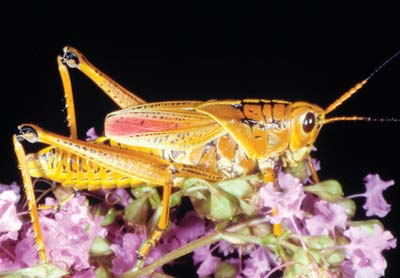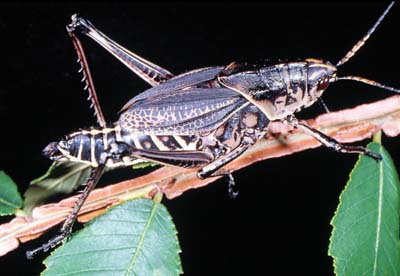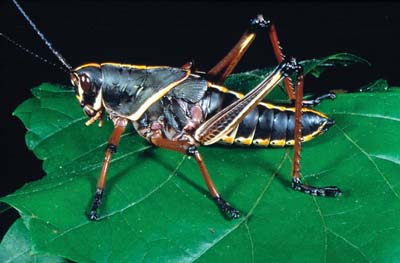Eastern Lubber Grasshopper, Romalea microptera
(Orthoptera: Acrididae)
The eastern lubber grasshopper is common in the southeastern states from North Carolina to eastern Texas, including the entire peninsula of Florida. Though its preferred habitat seems to be low, wet areas in pastures and woods and along ditches, lubbers disperse long distances during the nymphal period. They are gregarious and flightless, but their migrations sometimes bringing large numbers into contact with crops where they damage vegetables, fruit trees, and ornamental plants. There is a single generation annually, with the egg stage overwintering. These grasshoppers are long-lived, and either nymphs or adults are present throughout most of the year in the southern portions of Florida. In northern Florida and along the Gulf Coast they may be found from March or April to about October. The eggs are laid in pods, which consist of rows of eggs positioned parallel to one another, and held together by a secretion. Normally there are 30 to 50 eggs in each pod. The female deposits the pod in the soil at a depth of 3 to 5 cm and closes the oviposition hole with a frothy secretion or plug. The plug allows the young grasshoppers easy access to the soil surface when they hatch. Duration of the egg stage is six to eight months.
Young nymphs are highly gregarious, and remain gregarious through most of the nymphal period, though the intensity dissipates with time. Normally there are five instars. The nymphs are mostly black with a narrow median yellow stripe along the pronotum and abdomen, along the edges of the pronotum, and on the lower side of the abdomen. The legs are well marked with red. Their color pattern is distinctly different from the adult stage, and so the nymphs commonly are mistaken for a different species than the adult form. About 40 to 60 days are required for nymphal development. The adults are colorful, but the color pattern varies. In strong contrast to the nymph, the adult eastern lubber normally is mostly yellow or tawny, with black on the distal portion of the antennae, on the pronotum, and on the abdominal segments. The forewings extend two-thirds to three-fourths the length of the abdomen. The hind wings are short and incapable of providing lift for flight. The forewings tend to be pink or rose in color centrally whereas the hind wings are entirely rose in color. Darker forms of this species also exist, wherein the yellow color becomes the minor rather than the major color component, and in northern Florida a predominantly black form is sometimes found. Adults attain a large size, males measuring 43 to 55 mm in length and females often measuring 50 to 70 mm, sometimes 90 mm.
Lubber grasshoppers are defoliators, with a broad host range, consuming the leaf tissue of numerous shrubs, herbs, broadleaf weeds, and grasses. Insecticides applied to the foliage or directly to the grasshopper will prove lethal. However, due to their large size they often prove difficult to kill. Insecticide treatment is more effective for young grasshoppers.
Images
To save the Web-optimized images shown below to your hard drive:
PC users: right click to "Save Picture (or Image) As..."
Mac users: click and drag to your desktop.
Copyright © 2005 University of Florida


